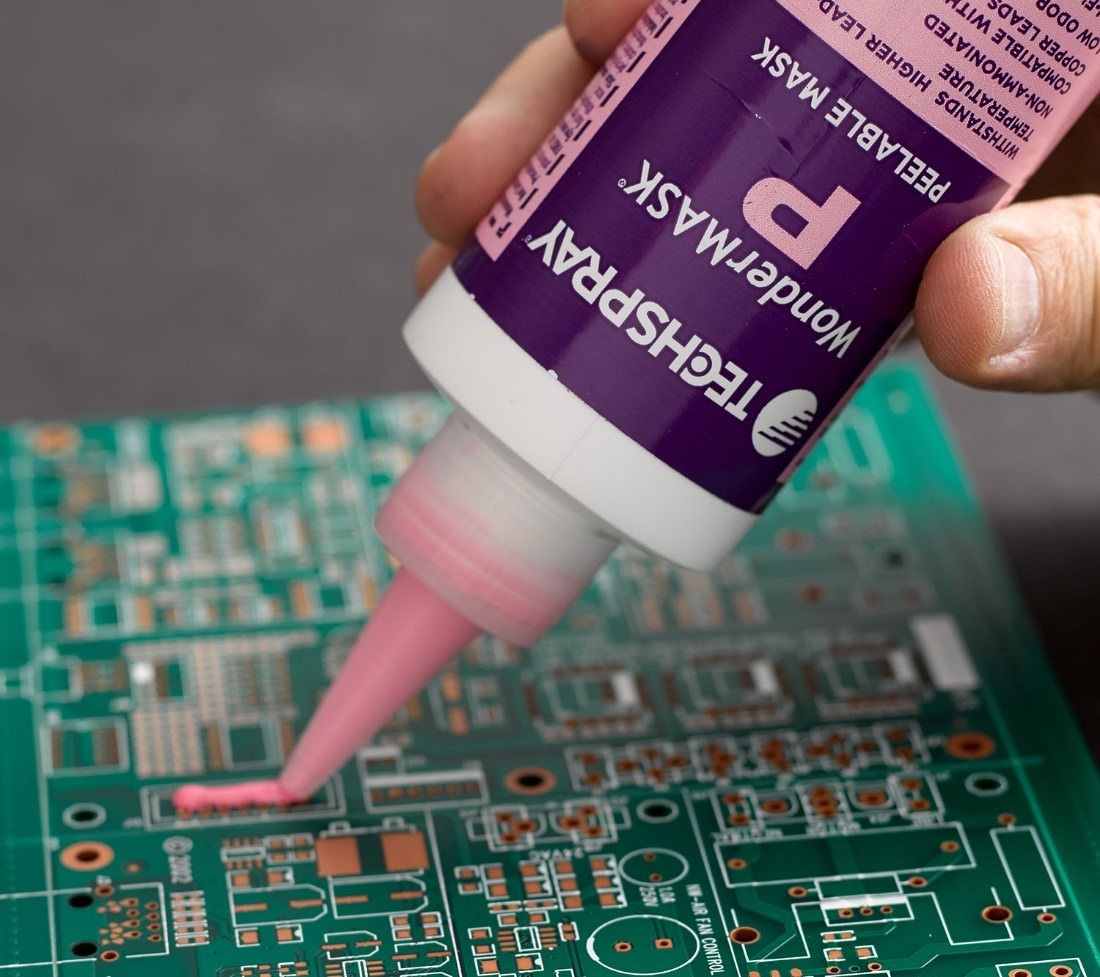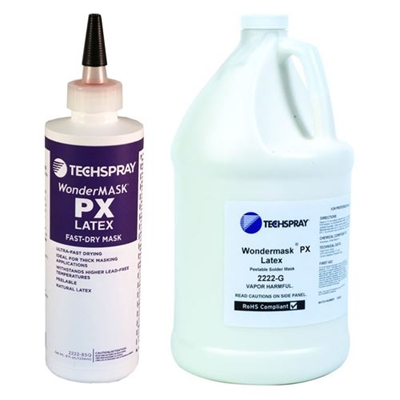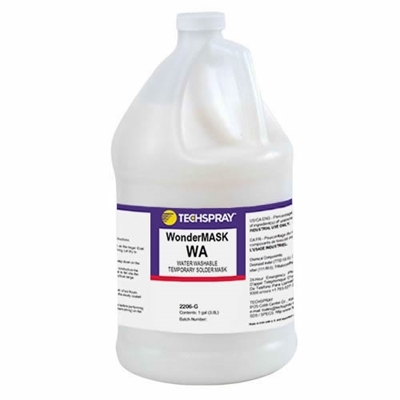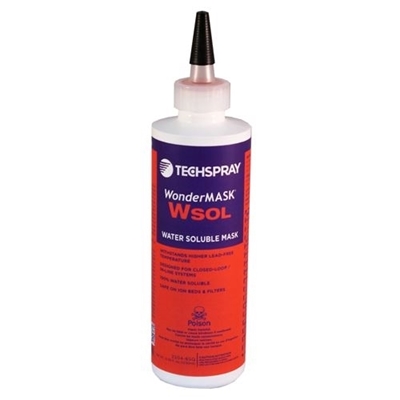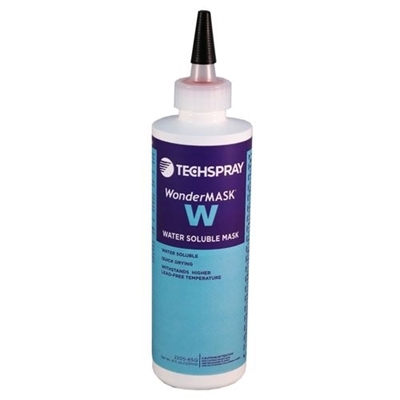Say you’re a contract manufacturer of printed circuit boards (PCBs), and your customer just made an engineering change that leaves several thru-hole vias open. If you run it through the wave as is, and solder over the vacant holes, the PCB won’t function properly. How do you keep the project on schedule and within budget?
Spot mask, commonly called “temporary solder mask”, can be used to protect open thru-holes or “vias” in wave soldering. Solder does not wet or stick to it, and it withstands soldering temperatures without charring or bubbling. When you are done, the mask can be peeled off, or will wash off in your PCB cleaning process.
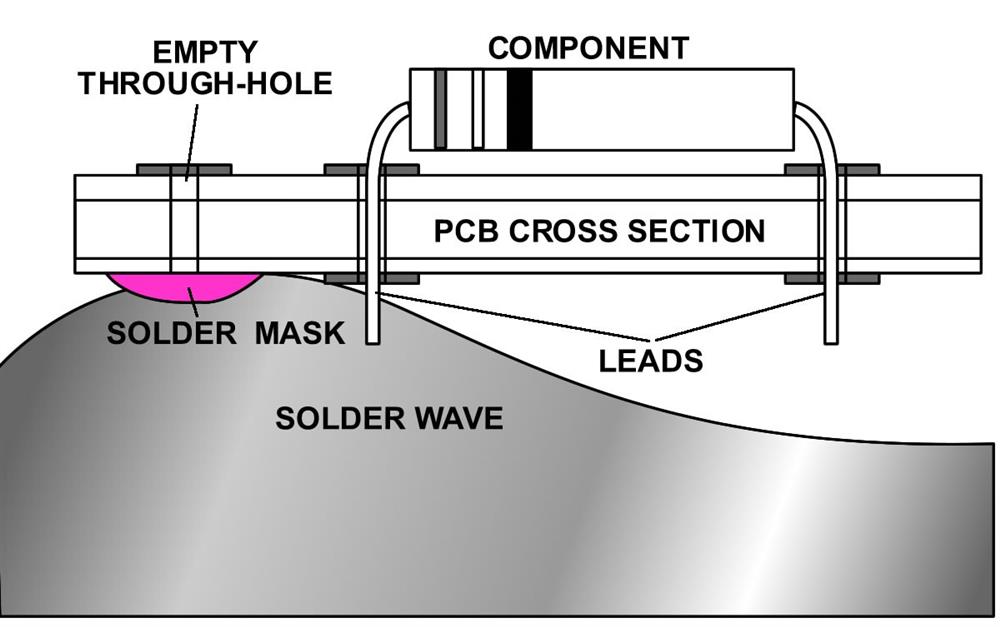
Why do you need spot mask? PCBs are commonly engineered for a variety of different models, so some areas of the board may be vacant depending on the features of a particular model. That allows for greater economies of scale for bare board production, but can add complexity to the assembly process.
Mask is applied over the open thru-holes on a circuit board in the wave soldering process to make sure they stay open. If the vias weren’t masked, any contact area on the bottom of the PCB would be fluxed and subsequently soldered. However, solder does not stick to mask, so the area underneath will remain solder-free.
Mask for conformal coating
Another common use for temporary solder mask is to protect contact areas and chemically sensitive components when spraying or dipping conformal coating. To some degree, conformal coating is electrically insulative so if you coat over a contact area, it will negatively impact its conductivity.
In addition, some components are made of sensitive materials that can be damaged by the harsh solvents used in conformal coating, so they must be protected with spot mask. Electromechanical components with moveable parts likewise need to be protected.
Solder mask vs. solder resist
While it is often called “solder mask”, don’t confuse this temporary solder mask with “permanent” solder mask, also called “solder resist”. Temporary solder mask should not be used to repair solder resist. If you need to repair cracks or chips in a PCBs overcoat, Techspray offers TraceTech Green Overcoat Pen.
Mask vs. Kapton tape & boots
Other options besides temporary solder mask include polyimide tape (commonly called Kapton Tape, a brand of E.I. du Pont de Nemours) or pre-formed silicone masking boots. These products can be used to cover select areas of the circuit board. Polyimide tape is popular because it is readily available and applies quickly, without cure time. A boot simply snaps onto the area to be masked.
The main advantage of temporary solder mask over these other methods is flexibility. Kapton tape generally comes in rolls or die-cut shapes. Masking boots are preformed, so must be ordered well ahead of a production run. These solutions work 80% of the time, but there are always those special circumstances that can take you by surprise. That’s where spot mask is a perfect fit!
Additionally, tape adhesive residue can cause wetting issues for conformal coating, while boots require periodic cleaning of baked-on flux or must be discarded.
Techspray WonderMASK® Temporary Solder Mask can protect plated thru-holes, contacts, pins, posts, terminals and gold fingers during wave soldering. These products provide short-term high-temperature protection from molten solder and will not leave ionic or corrosive residue. WonderMASK® Solder Masks are available in convenient squeeze bottles for a precision application or in gallons for automated applications.
Common Applications for Temporary Solder Mask
If you think of spot mask like liquid masking tape, you can imagine all kinds of creative uses for it. EMS process engineers are constantly challenged with meeting the requirements of a wide variety of customers. Solutions often must be found within tight timelines and within budgets that have been set without all the variables taken into account. Temporary solder mask is an important tool in the process engineer’s toolbox because it can be plugged into a variety of applications to solve immediate assembly problems:
- Protecting open vias in wave soldering – As mentioned above, this is the most common use for spot mask. To ensure vias stay open, and not soldered in the wave soldering process, mask is strategically applied. Solder doesn’t wet to mask, so the areas underneath will remain solder-free.
- Masking conformal coating – When spraying conformal coating onto a PCB or dipping the board into coating, there are often areas that shouldn’t be coated, like contact areas. Conformal coatings are generally electrically insulative, so if you coat over a contact area, it will negatively impact its conductivity. In addition, some components are made of sensitive materials that can be damaged by the harsh solvents used in conformal coating; these need to be protected with spot mask. This is less of an issue when using a selective spray system, but if applying coating from an aerosol can, hand sprayer, or via a dipping process, masking will often be necessary.
- Masking around components – SMT (surface mount technology) and BGA (ball grid array) components commonly have very low stand-off areas (the space between the component and the surface of the board). Even when applying conformal coating with a selective spray system, there is a risk of the material wicking under the component through capillary action. Mask can be applied around the component to create a dam.
- Holding components in place when soldering two-sided boards – When assembling two-sided SMT circuit boards, it can be a challenge to solder components on the bottom-side of the board without affecting the components on the top. On the first pass through the reflow oven, gravity holds the components in place as the solder melts and then solidifies. But on the second pass through the reflow oven, larger components can have more of a tendency to drop off the underside. Temporary solder mask can be applied to the corners of BGAs and other large components to hold them in place, then be removed after the assembly process.
- Protecting heat-sensitive components in the reflow process – Mask can provide thermal insulation for heat-sensitive components that must pass through a wave or reflow soldering process. However, since temporary solder mask isn’t engineered for this application, manufacturers will probably be of little help qualifying the product for this purpose.
How to Apply Temporary Solder Mask for Wave Soldering
Spot mask can be hand applied, dispensed with a pneumatic system, or stencil printed. Each application method has its own advantages, disadvantages, and challenges.
Manually / hand application
Manual mask application is the most common method because it is simple, requires little set-up, and no capital equipment investment. You simply squeeze the bottle to apply mask where desired. Even though that sounds fool-proof, how the bottle is held can affect mask removal.
It is common to hold the squeeze bottle vertically 90° as you move the dispensing tip across the board. This can cause three potential problems:
- Mask can stick to the inside of the vias and mushroom out on the other side. This creates a plug on the bottom side, and increases the chance of breakage when removing the mask. .
- If removing the mask in an aqueous cleaning system, the water will have trouble penetrating the masked holes.
- When holding the bottle at 90°, the bead of mask tends to be thinner. This bead is your draw-string when peeling the mask off, so a thinner strip is more likely to break.
If you hold the bottle at more of an angle, 60°, the bead will be the proper thickness and allow more precise application reducing these potential problems.
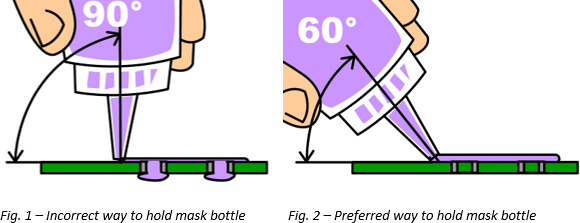
Pneumatic Mask Dispensing
Pneumatic dispensing systems reduce the variability in the application process. When using a pneumatic dispensing system, mask is pressurized with either compressed air or nitrogen and pushed through a dispensing tip. Clogged tips are the biggest headache with this method.
Many masks have high shear-curing, which means pressure accelerates the curing process. If that is the case, the mask will tend to clog the dispensing tip as the pressure increases. WonderMASK P peelable mask, or WonderMASK WSOL and WonderMASK W washable masks have high shear curing, so will avoid this problem.
Cured bits of mask in the tank is also a concern, because it can be drawn through the dispensing system and clog the tip. Using nitrogen instead of ambient air to pressurize the system can avoid curing in the tank. If there is skinning in the tank or in the original mask container before the material is transferred, peel off the cured mask instead of mixing it into the uncured material.
If the viscosity of the mask needs to be reduced (to thinner consistency), carefully mix in deionized (DI) water. Mix slowly to avoid whipping, which adds air bubbles to the mask and can create voids.
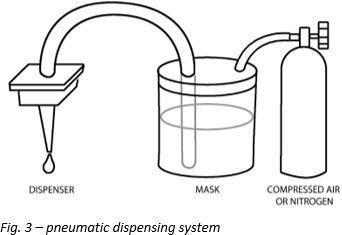
Stencil Printing Mask
It is not uncommon for Mask to be applied with a stencil, which is similar to SMT solder paste printing. Choosing an appropriate mask for stencil printing is critical, because viscosity has to be high enough to be printed without flowing under the stencil. Washable masks make stencil cleaning easiest. Peelable masks either have to be cleaned before curing or peeled after it fully cures. Avoid screen printing with a fine mesh screen because of potential cleaning problems.
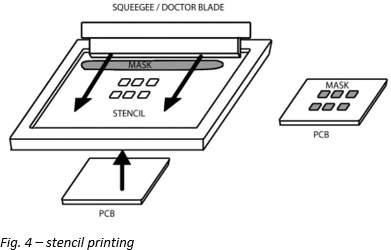
How to Apply Temporary Solder Mask for Conformal Coating
Using mask for conformal coating is a simple process that requires little set-up, and no capital equipment. First you apply the mask to the contact areas and allow the mask to fully cure. Then you apply the conformal coating over the masked area. After the coating is dry to the touch, but before it is fully cured, peel off the mask.
Peelable mask is recommended for conformal coating. Conformal coatings repel water, so a washable mask will be difficult to remove from under the coating. Natural latex is recommended as synthetic mask material can interact with the harsh solvents used in conformal coating. For the cleanest masked edge, peel the mask before the coating is fully cured. Otherwise it could create a cracked, ragged edge, or even dislodge the coating.
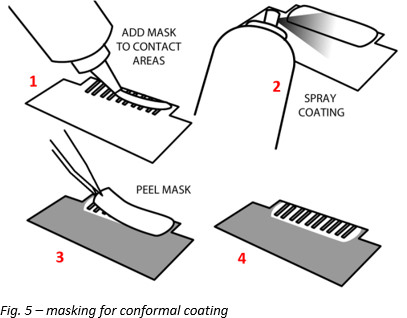
Curing Temporary Solder Mask
Since fully curing mask can take anywhere from 30 minutes to a full day, the curing process requires planning to avoid bottlenecking the PCB assembly process.
While it might be tempting to rush this step, it could cause serious problems. When uncured mask touches molten solder, the liquid components of the mask instantly vaporize and, if the cured skin is not thick enough, the expanded air will bubble out. This can open voids in the mask and even throw solder beads over the PCB.
The pre-heat cycle in wave soldering equipment can speed up curing, but some pre-curing is still recommended. Therefore, test the masked board before it is placed on the conveyor; it should be non-tacky with a thick skin. Beyond that, you will need to test within your own process because it depends on the mask material, the thickness of the bead, and the thermal profile. We do not recommend changing your equipment thermal profile to speed up the mask curing process. That can lead to other problems, like thermally stressing sensitive components.
If speed is the most important factor, consider natural latex solder masks. WonderMASK PX is the fastest curing mask available, so will fully cure within 20 minutes, depending on the thickness of the bead. Instead of skinning over, then curing on the inside like most masks, WonderMASK PX skins but thickens and cures throughout simultaneously. It is the perfectly suited product when thick beads of mask are required.
How To Remove Temporary Solder Mask
Temporary solder mask needs to be removed at the end of the PCB assembly process. Peelable masks are commonly removed by hand or with tweezers. Techspray offers several peelable masks:
- WonderMASK P is a synthetic latex mask, so does not contain ammonia. This makes it easier for personnel, and safer on sensitive metals like gold, brass or aluminum.
- WonderMASK PX is our fastest curing mask, and ideal when you are applying thick beads.
- Techform TC-533 was previously available from Kester. It cures quickly and has high tensile strength. It is ideal if breakage is a concern, or for conformal coating.
Washable mask is designed to be removed in aqueous inline or batch wash systems. If you are using a closed-loop system, which filters and recirculates wash water, make sure you use a mask that is compatible with your physical filters and ion beds. Techspray offers three different washable masks:
- WonderMASK WSOL is fully soluble in water, so is compatible in closed-loop wash systems. It will not damage ion filter beds or clog mesh filters.
- WonderMASK W is nonflammable and cures more quickly than WonderMASK WSOL.
- WonderMASK WA is similar to WonderMASK W, but with a viscosity that is better suited for pneumatic dispensing systems.
If you are removing mask in an inline or batch aqueous system and are experiencing foaming, it is an indication that either a) too much mask material is being passed back into your cleaning system or b) it is interacting with dissolved flux in the same wash water. This is generally solved by replacing your wash water with fresh DI water. Techspray Defoamer DF1 can be added as a stopgap solution.
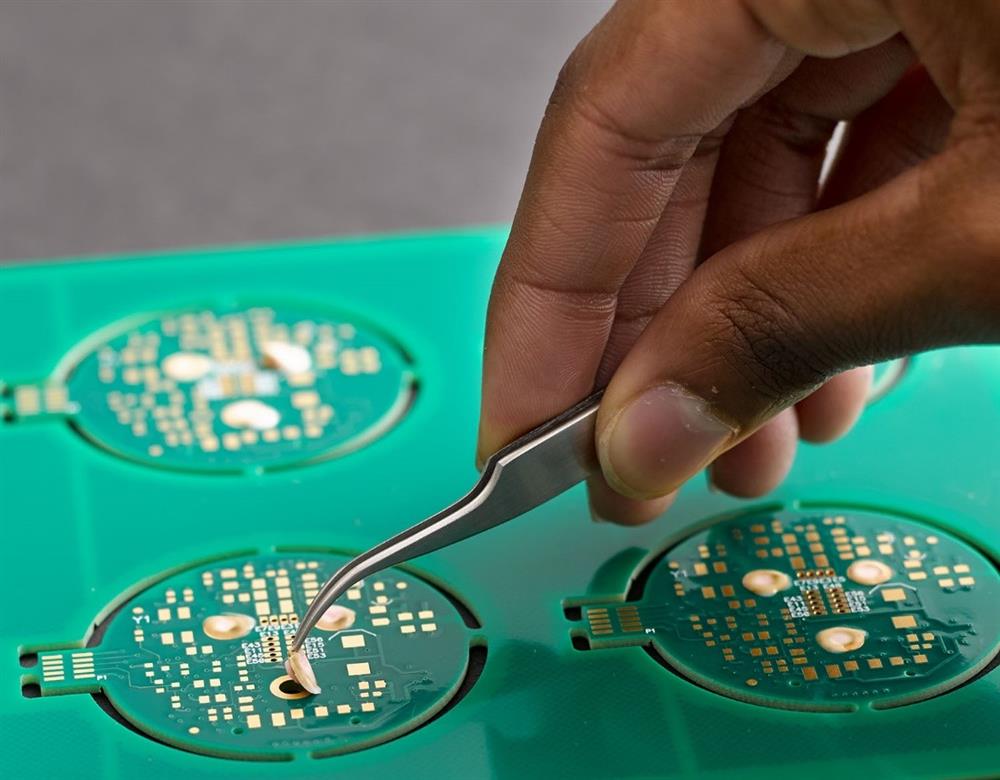
Techspray’s lab is available to help you qualify products, establish your masking process, or diagnose masking issues. For more information, go to www.techspray.com or call 800-858-4043.

